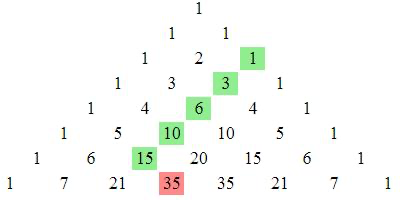Problems
What’s the sum of the squares of the numbers in the \(n^{\text{th}}\) row?
Let \(p\) be a prime number. What do you notice about the numbers other than \(1\) in the \(p^{\text{th}}\) row? Can you prove it?
The picture below shows the ‘hockey-stick’ identity in Pascal’s triangle.

It says that if you start one of the diagonals formed of \(1\)s at the edge, then follow the numbers diagonally in one direction (e.g. left in the picture) and then change direction on your final turn (right in the picture), then the sum of the all but the last number is equal to the last number.
Prove this is true. Written algebraically, \[\binom{r}{r}+\binom{r+1}{r}+...+\binom{n-1}{r}+\binom{n}{r}=\binom{n+1}{r+1},\] where \(0\le r\le n\).
In the \(n^{\text{th}}\) row of Pascal’s triangle, leave the left \(1\) untouched, multiply the next number along (which is \(\binom{n}{1}=n\)) by \(2\), multiply the next number along (which is \(\binom{n}{2}=\frac{n(n-1}{2}\)) by \(4\), and so on, until you multiply the right-hand \(1\) by \(2^n\). That is, multiply the \(k^{\text{th}}\) number from the left by \(2^k\).
Now what’s the sum of the numbers in the \(n^{\text{th}}\) row?
Let \(s_n\) be the product of the numbers in the \(n^{\text{th}}\) row. (e.g. \(s_3=1\cdot3\cdot3\cdot1=9\)) What’s the limit \[\lim_{n\to\infty}\frac{s_{n-1}s_{n+1}}{s_n^2}?\]
Other than \(1\), does any number appear more than eight times in Pascal’s triangle?
Approximately how many footsteps do I take in a year? (estimate to the nearest power of \(10\))
What’s \(2\uparrow\uparrow\uparrow\uparrow\uparrow\uparrow\uparrow\uparrow\uparrow\uparrow2\)?